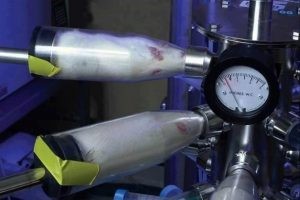Inhalation tests are carried out in chemical testing, but also in basic or applied research. For these tests, mainly rats are used, in basic and applied research also mice and other rodents. In the database of the Federal Institute for Risk Assessment in Berlin, 2,726 rats have been found in 2019 alone in numerous inhalation toxicological test authorizations (legally required animal experiments), and not all applications for the year under consideration have yet been recorded. basic research and applied/translational research were not included.
In these tests, rodents had to inhale gases or dust for 6 hours per day, 5 days a week, for 90 days in long-term experiments. Before, they are squeezed into an apparatus in which they cannot move. After the experiments, they are killed in order to examine the tissue.

Rats in an inhalation apparatus.
Photo: Human Toxicology Project.
This could be phased out in the future if the new, animal-free developments with human cells and data have been positively validated at the end.
The Fraunhofer Institute for Biomedical Engineering IBMT is developing sensitive in vitro systems from human lung and liver cells. These systems will simulate the human lung barrier, while the in-vitro liver model will simulate the metabolism process in the liver. Both tissue models will be integrated into a microfluidic system. After exposure to toxic substances or therapeutic agents, specific effects after a pulmonary uptake into the organism will be investigated. The analysis results from the examinations with the system will then serve as the basis for the development of the in-silico model.
The Fraunhofer IBMT supplies the microfluidic chip system and the human toxicological analysis system connected to it. The Medical Clinic V of Saarland University contributes to clinical data. Here, the scientists are particularly concerned with cell biological aspects and specific human disease models, such as COPD. The Faculty of Pharmacy at Saarland University is developing the bioinformatics analysis methods.
The project is coordinated by Prof. Dr. Dr. Robert Bals from Saarland University (coordination), Clinic for Internal Medicine V. Other participants are Prof. Dr. Thorsten Lehr from the Clinical Pharmacy of Saarland University and the Fraunhofer Institute for Biomedical Engineering IBMT in Sulzbach.
Source:
https://www.ibmt.fraunhofer.de/de/ibmt-presse-uebersicht-2020/presse-BMBF-Vision-2020-07-13.html




 Dr. rer. nat.
Dr. rer. nat. Menschen für Tierrechte - Tierversuchsgegner Rheinland-Pfalz e.V.
Menschen für Tierrechte - Tierversuchsgegner Rheinland-Pfalz e.V.